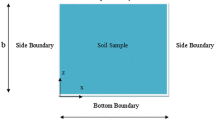Abstract
Flows in variably saturated media that exhibit second-type heterogeneity, in which abrupt changes of medium parameters occur, are simulated by the Green element method (GEM). Such media are usually encountered where soil formations have arisen by different geological or geomorphological processes spread over different time scales. Two challenges are posed when simulating flows in multiply zoned unsaturated media: one is the highly nonlinear nature of the flow within each zone, and the other is dealing with sharp contrast in medium parameters at the interfaces of different zones. Both challenges are accommodated in this paper using a flux-based Green element formulation to simulate the flow and incorporating the Picard and Newton–Raphson (N-R) algorithms to simplify the nonlinear discrete equations. Calculations are carried out on three numerical examples of infiltration into unsaturated soils in two spatial dimensions. The convergence rate of the N-R algorithm is superior to the Picard algorithm only for the first example, while none of the algorithms has a clear advantage for the other two examples. The N-R algorithm suffers from repeated calculation of derivatives of the medium parameters with respect to the pressure head, thereby compromising the accuracy of the solution and increasing computational cost.
Similar content being viewed by others
References
Bear, J.: 1979, Hydraulics of Groundwater, McGraw-Hill, NY, pp. 218-220.
Celia, M. A., Bouloutas, E. T. and Zarba, R. L.: 1990, A general mass-conservation numerical solution for the unsaturated flow equation, Water Resour. Res. 26(7), 1483-1496.
Haverkamp, R., Vauclin, M., Touma, J., Wierenga, P. and Vachaud, G.: 1977, Comparison of numerical simulation models for one-dimensional infiltration, Soil Sci. Soc. Am. J. 41, 285-294.
Huyakorn, P. S., Thomas, S. D. and Thompson, B. M.: 1984, Technique for making finite elements competitive in modeling flow in variably saturated porous media, Water Resour. Res. 20(8), 1099-1115.
Liggett J. A. and Liu P. L-F.: 1983, The Boundary Integral Equation Method for Porous Media Flow, Allen & Unwin Mass, pp. 24-25.
Martinez, M. J. and McTigue, D. F.: 1992, A boundary integral method for steady flow in unsaturated porous media, Int. J. Num. Anal. Meth. Geomech. 16, 581-601.
Moldrup, P., Rolston, D. E. and Hansen, J. A. A.: 1989, Rapid and numerically stable simulation of one-dimensional transient water flow in unsaturated, layered soils, Soil Sci. 148(3), 219-226.
Pan, L. and Wierenga, P. J.: 1995, A transformed pressure head-based approach to solve Richards' equation for variably saturated soils, Water Resour. Res. 31(4), 925-931.
Paniconi, C., Aldama, A. A. and Wood, E. F.: 1991, Numerical evaluation of iterative and noniterative methods for the solution of the nonlinear Richards equation, Water Resour. Res. 27(6), 1147-1163.
Paniconi, C. and Putti, M.: 1994, A comparison of Picard and Newton iteration in the numerical solution of multidimensional variably saturated flow problems, Water Resour. Res. 30(12), 3357-3374.
Pullan, A. J.: 1988, Boundary element solutions of quasilinearised time-dependent infiltration, Appl. Math. Model. 12, 9-17.
Taigbenu, A. E.: 2000, Unsaturated-flow simulation with Green element models, ASCE J. Hydraul. Engng (in press).
Taigbenu, A. E.: 1999a, Performance of Picard and N-R algorithms in Green element simulations of unsaturated flows, Proc. 21st Int. Conf. on the Boundary Elements XXI, Oxford University, UK, pp. 629-638.
Taigbenu, A. E.: 1999b, The Green Element Method, Kluwer Academic Publishers, Boston, USA, pp. 335-338.
Taigbenu, A. E.: 1995, The Green element method, Int. J. Num. Meth. Engng 38, 2241-2263.
Taigbenu, A. E. and Sada, E.: 1992, A Green element model for variably saturated groundwater flow, Proc. Int. Conf. on Computational Methods in Water Resources, University of Colorado at Denver, USA, pp. 219-227.
Taigbenu, A. E. and Onyejekwe, O. O.: 1995, Green element simulations of the transient unsaturated flow equation, Appl. Math. Model. 19, 675-684.
Tsai, W-F., Chen, C-J. and Tien, H-C.: 1993, Finite analytic numerical solutions for unsaturated flow with irregular boundaries, J. Hyd. Engng, ASCE 119(11), 1274-1298.
Warrick, A. W.: 1991, Numerical approximations of Darcian flow through unsaturated soil, Water Resour. Res. 27, 1215-1222.
Zaidel, J. and Russo, D.: 1992, Estimation of finite difference interblock conductivities for simulation of infiltration into initially dry soils, Water Resour. Res. 28(9), 2283-2295.
Author information
Authors and Affiliations
Rights and permissions
About this article
Cite this article
Taigbenu, A.E. Simulations of Unsaturated Flow in Multiply Zoned Media by Green Element Models. Transport in Porous Media 45, 385–404 (2001). https://doi.org/10.1023/A:1012080207432
Issue Date:
DOI: https://doi.org/10.1023/A:1012080207432




